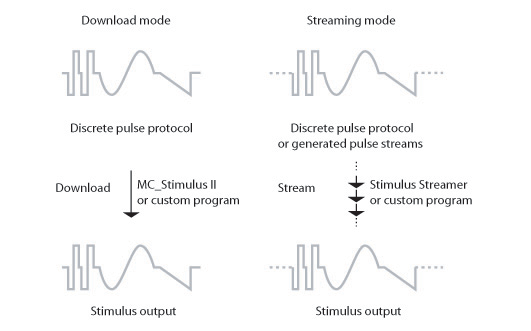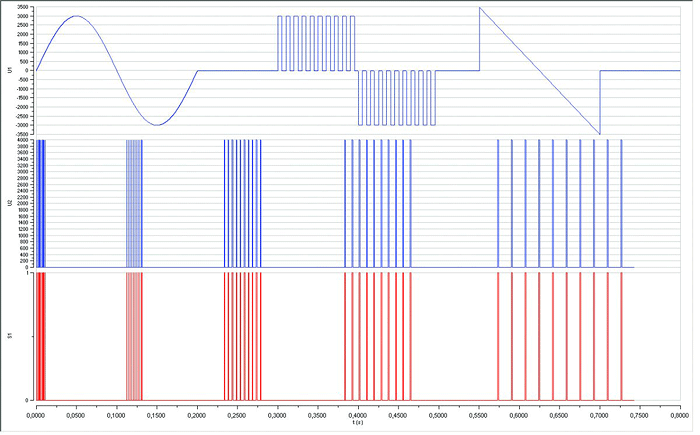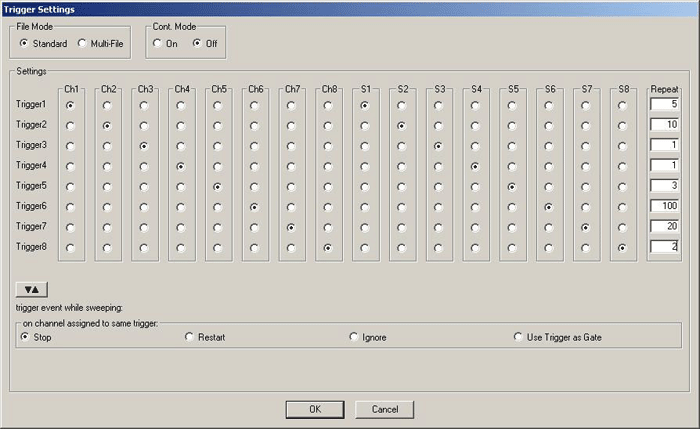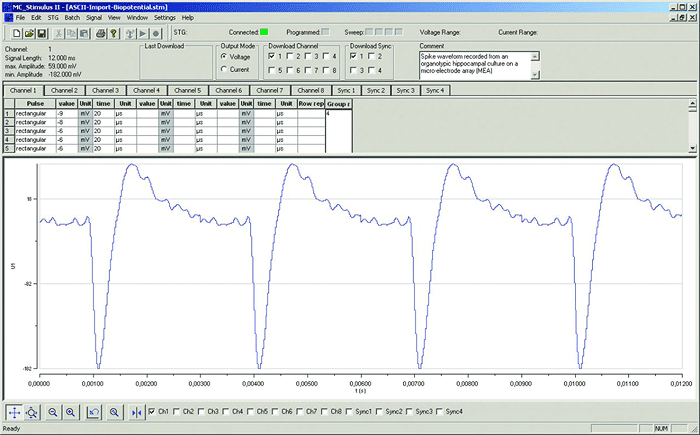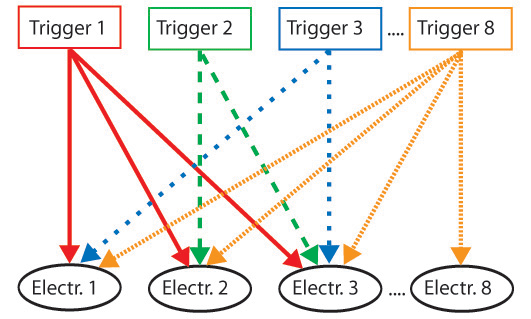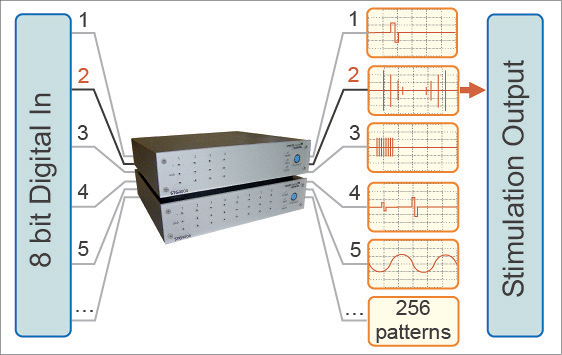(STG4000 Series) MCS Stimulus Generators
Product Summary
Stimulus Generators for Current and Voltage Driven Stimulation
The STG family of stimulus generators are available with 2, 4 or 8 independent output channels. Featuring integrated isolation units for each output channel, the STGs are able to provide any arbitrary waveform.
- Current driven stimulation
- Voltage driven stimulation
- Provides control and timing
A stimulus isolation unit (SIU) is included for each stimulation channel. Therefore, no external SIU is required. You just need to plug in your STG and start your experiment.
Every stimulation channel is freely programmable. You can design any arbitrary analog waveform as stimulation signal for every single channel. There is no need to combine channels to achieve complex stimulation patters, but they can be created for every separate channel either by the included software MC_Stimulus II or by downloading any biological signal to the STG.
TTL in-/outputs for every stimulation output
The stimulators can receive and deliver TTL pulses via BNC connectors for every single stimulation output. These triggers allow you to control and synchronize other instruments like imaging systems, LED-lights, data acquisition systems, and many more - at a 20 µs precision.
Voltage or current mode selectable via software
The STGs of the 4000 series offer the possibility to select the output mode via software. This way, you can switch between voltage and current stimulation quickly and easily.
For the perfect adaption to your experiment, you can select between STG versions with three different current outputs, the voltage output stays the same, no matter which version you choose.
Dynamic online changes and downstreaming
The stimulus generators of the 4000 series are the only commercially available pulse generators that can dynamically change the output signal and downstream pulses during stimulation. Thus, you can stimulate continuously over several days, weeks, even months, and generate stimulation sequences on the fly during the experiment.
Imagine the possibilities of the system, like feedback studies or modulated white-noise stimulation. The Stimulus Streamer, a basic program for loading and playing ASCII and MP3 files, will be provided, but you can integrate the program controls (DLL) into your custom program as well. For example, you can use biological signals recorded with your custom data acquisition system and feed the data directly into the stimulus generator, making it perfect for neuronal network studies.
Freely programmable waveforms
You can easily design your own waveforms with the WYSIWYG editor of the included stimulus software: freely combine mono- or biphasic rectangular pulses, ramps, or sine waveforms to design stimulation patterns of unlimited complexity on each output channel.
Single pulses can be grouped and looped to generate pulse trains with individual timing and intervals. You can apply a completely different protocol to each of the up to 8 stimulation outputs. Repeat your stimulation protocol as many times as you need or let it run infinitely and then stop it manually or on a trigger event. An internal quartz-controlled clock guarantees precise timing over a long period.
Triggering stimulation
Every stimulation pattern can be started and stopped manually or on an external trigger (TTL), for example from a switch or any other external control.
The STG4000 series allows you to trigger each of the up to 8 analog output channels independently.
Each stimulator is equipped with one TTL output and one TTL input for each stimulation channel. The stimulation on up to 8 channels can be controlled by the same trigger (synchronous operation) or by different triggers (independent or asynchronous operation).
This way, you can apply up to 8 complex stimulation patterns to separate stimulating electrodes with a precise timing based on different trigger sources or criteria.
Importing external ASCII files
You can also import files generated by external programs, for example biological signals captured by a data acquisition system or curves derived from complex mathematical functions.
Imported signals can be further edited, grouped, or repeated directly in the included stimulus software MC_Stimulus and are simply downloaded onto the stimulus generator by a single mouse click. The example shows a spike waveform recorded from an organotypic hippocampal culture on a Microelectrode Array (MEA) at a sampling rate of 50 kHz after the ASCII import
Multi File Mode
In addition to switching between different stimulation protocols on separate channels, the Multi File Mode makes it possible to switch between different patterns on the same electrode(s). You can load up to 8 different stimulation files, each containing the individual program for up to 8 separate stimulating electrodes. Each stimulation file is controlled by a separate trigger. This feature allows you to switch rapidly between up to 8 different stimulation protocols on the same or overlapping channels.
For example, you can control stimulation pattern A (red arrows in the figure) by trigger 1 on electrode 1, 2, 3, and stimulation pattern B (green arrows) by trigger 2 on electrode 2 and 3, and so on. With this feature, you can react with different pulse patterns in response to the biological behavior.
Extended Multi File Mode
The extended Multi File Mode is controlled through the Digital In (D-IN) of the stimulus generator. The D-IN has an 8 bit resolution and can assume 256 different states. Correspondingly, up to 256 stimulation patterns (files) can be downloaded to the stimulus generator and each pattern can be assigned to one state of the D-IN. Each of these stimulation patterns can define the output of one or more of the STG’s stimulation and SyncOut channels.
With the D-IN interface you can now automatically switch between different stimulation patterns with a latency of only a few microseconds. There are two modes available for the Extended Multi File function, continuous and triggered. In continuous mode, the STG continuously monitors the state of the D-IN and starts the assigned stimulation pattern as soon as the state of the D-IN changes. In triggered mode, the same happens only when an additional external trigger is applied.
Related Files
Customers from Europe and Australia can use the Multi Channel Systems - Online Shop to order Warner products or create quotes.
Pricing Top Description
...
| Order No. | Model No. | Product Description | USA Price | Order |
|---|---|---|---|---|
| Field Stimulation Chambers | ||||
| 64-0226 | RC-21BRFS | Imaging chamber with field stimulation | Login | Login |
| 64-0240R2 | RC-27NE2 | Narrow Bath Recording Chamber w/ Field Stimulation | Login | Login |
| 64-1725 | RC-49MFSH | Magnetic Imaging / recording chamber with removable electrodes and heating elements | Login | Login |
| 64-0374 | RC-47FSLP | Quick change chamber for 25 mm coverslips, with field stimulation | Login | Login |



